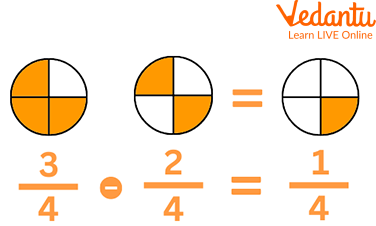




Introduction to Fractions
Fractions are simply numbers in which the numerator is divided by the denominator. Fractions can get a little complicated when it comes to simple operations like addition and subtraction. When the denominators of given fractions are the same, we can add the numerators directly. However, when the denominators are different, such fractions need to be solved using a different method. Don’t worry, we’ve got you covered. In this chapter we’ll learn about adding and subtracting unlike fractions, addition and subtraction of fractions with unlike denominators, steps for addition and subtraction of unlike fractions, and addition and subtraction of like and unlike fractions.

Additions and Subtraction of Unlike Fractions
What are Like Fractions?
Like fractions are fractions that have the same denominators. For example,
What are Unlike Fractions?
Fractions that have different denominators are known as, unlike fractions. For example,
Let us see how to perform these operations on such fractions.
Adding and Subtracting Like Fractions
Let us add the fractions with like denominators in numerical terms. In this case, we need to add
Step 1: Add the numerators of the given fractions. Here, the numerators are 1 and 2, so it will be 1 + 2 = 3
Step 2: Retain the same denominator. Here, the denominator is 5.
Step 3: Therefore, the sum of
Now, let us subtract the fractions with like denominators in numerical terms. In this case, we need to subtract
Step 1: We will subtract the numerators of the given fractions. Here, the numerators are 2 and 1, so it will be 2 - 1 = 1
Step 2: Retain the same denominator. Here, the denominator is 5.
Step 3: Therefore, the difference of
How to Add or Subtract Fractions with Unlike Denominators?
When the given fractions have a different denominator, we cannot add the numerators directly without considering the denominators. Below are the steps for the addition and subtraction of unlike fractions. Firstly we will see the steps for addition.
Steps for Addition of Unlike Fractions
Example: Add
Ans: For adding unlike fractions, we need to use the following steps
Step 1: Find the denominators Least Common Multiple (LCM).
Here, the LCM of 5 and 3 is 15.
Step 2: Convert the given fractions to like fractions by writing the equivalent fractions for the respective fractions such that their denominators remain the same. Here, it will be
Step 3: Similarly, an equivalent fraction of
Step 4: Now that we have converted the given fractions to like fractions, we can add the numerators and retain the same denominator. This will be
Steps to Subtract Fractions with Unlike Denominators
Let’s understand it, with an example.
Example: Subtract
Solution: For subtracting unlike fractions, we need to use the following steps.
Step 1: Find the denominators Least Common Multiple (LCM). Here, the LCM of 6 and 3 is 6.
Step 2: Convert the given fractions to like fractions by writing the equivalent fractions for the respective fractions such that their denominators remain the same. Here, it will be
Step 3: Similarly, an equivalent fraction of
Step 4: Now that we have converted the given fractions to like fractions, we can subtract the numerators and retain the same denominator. This will be
Solved Examples
Below is an example of some of the problems based on the addition and subtraction of fractions with unlike denominators
Q 1.
Ans: The fractions
LCM of 9 and
Multiply
Multiply
Now,
Thus, upon adding
Q 2.
Ans: The fractions
LCM of 9 and
Multiply
Multiply
Now,
Thus, upon adding
Q 3. Subtract
Ans:
Multiply
Multiply
Hence,
Thus, the required answer is
Worksheet for Addition and Subtraction of Unlike fractions
Below are some of the questions based on adding and subtracting unlike fractions and like fractions.
Q 1.
Q 2.
Q 3.
Q 4.
Summary
Just like our counting numbers, fractions can also be easily subtracted and added. The rules for addition and subtraction of like and unlike fractions are quite simple and it involves three steps to do so: finding the same common denominator if it's an unlike fraction, then adding or subtracting the numerators. And if the answer is an improper form you have to reduce the fraction into a mixed number. Solving these unlike fractions using the given steps is easy once you grasp the important step for finding the LCM and rationalizing the denominators. You can also download the addition and subtraction of unlike fractions worksheets PDF.
FAQs on How to Add and Subtract Unlike Fractions?
1. Do like fractions and unlike fractions have the same numerator?
Like fractions are fractions having the same denominators; the numerators can be the same or different. Unlike fractions are fractions have different denominators. The numerators in unlike fractions also can be the same or different.
2. How to Convert Unlike Fractions to Like Fractions?
Unlike fractions can be converted to like fractions by finding the lowest common multiple (LCM) of the denominators first and then calculating their equivalent fractions with the same denominator.
3. What are the seven types of fractions?
Seven types of fractions are as follows:
Proper fraction
Improper fraction
Mixed fraction
Like fraction
Unlike fraction
Equivalent fraction











